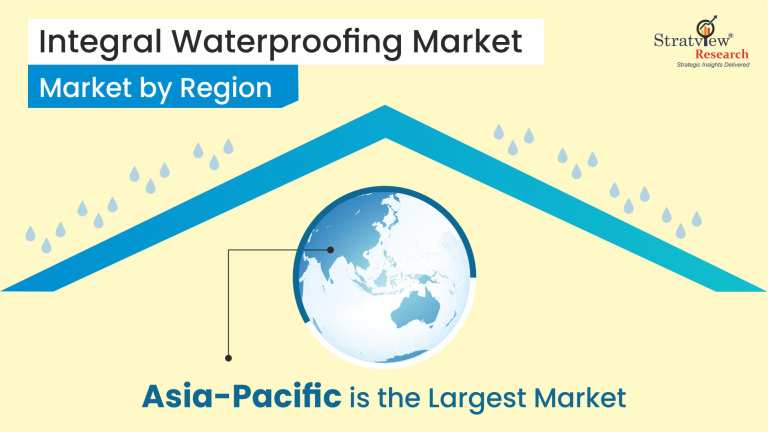In the ever-evolving landscape of modern construction, integral waterproofing has emerged as a critical solution to enhance the durability, sustainability, and longevity of buildings and infrastructure. This article explores the significant benefits of integral waterproofing and why it has become an essential component in construction projects worldwide.
According to Stratview Research, the Integral Waterproofing Market is likely to grow at a CAGR of 4.7% during 2023-2028 to reach USD 1.15 billion in 2028.
What is Integral Waterproofing?
Integral waterproofing is a method of waterproofing that involves adding waterproofing agents directly into the concrete mix during construction. This approach ensures that the entire concrete structure is protected from water penetration, as opposed to traditional methods that rely on surface-applied membranes or coatings. By integrating waterproofing agents into the concrete matrix, integral waterproofing provides a seamless and continuous barrier against moisture, enhancing the overall performance and lifespan of structures.
Key Benefits of Integral Waterproofing
Enhanced Durability and Longevity
Integral waterproofing significantly improves the durability and lifespan of concrete structures by preventing water ingress and associated damage. The waterproofing agents react with the concrete to form a barrier that blocks capillary pores and micro-cracks, reducing the risk of corrosion, spalling, and structural deterioration over time.
Reduced Maintenance Costs
By minimizing water infiltration and protecting against environmental factors, integral waterproofing reduces the need for costly repairs and maintenance. Structures treated with integral waterproofing require less frequent upkeep, resulting in lower lifecycle costs and improved operational efficiency.
Increased Structural Integrity
Waterproofed structures maintain their structural integrity even under harsh environmental conditions. Integral waterproofing protects concrete from freeze-thaw damage, chemical exposure, and other forms of degradation, ensuring that buildings remain stable and secure.
Improved Indoor Air Quality
Integral waterproofing helps to prevent moisture buildup within building materials, which can lead to mold, mildew, and indoor air quality issues. By keeping moisture out, integral waterproofing contributes to a healthier indoor environment for occupants.
Sustainability and Environmental Benefits
Sustainable construction practices are increasingly important in modern building design. Integral waterproofing supports sustainability efforts by reducing the need for additional waterproofing treatments, minimizing material waste, and extending the service life of structures. It also contributes to energy efficiency by reducing the energy consumption associated with heating and cooling.
Ease of Application
Integrating waterproofing agents into the concrete mix simplifies the construction process compared to traditional waterproofing methods. It eliminates the need for additional labor and materials associated with applying membranes or coatings, saving time and reducing construction costs.
Aesthetic Advantages
Unlike surface-applied waterproofing membranes, which can alter the appearance of architectural finishes, integral waterproofing is invisible and does not affect the aesthetic appeal of concrete surfaces. This allows architects and designers to maintain the desired look and feel of the building.
Applications of Integral Waterproofing
Residential Construction: Used in basements, foundations, and roof decks to protect against water infiltration and enhance livability.
Commercial Buildings: Provides waterproofing for parking structures, podiums, and other critical areas to maintain operational continuity.
Infrastructure Projects: Essential for tunnels, bridges, dams, and other infrastructure to ensure structural integrity and longevity.
Swimming Pools and Water Features: Protects concrete surfaces from water damage and chemical exposure in aquatic environments.
Case Studies: Success Stories of Integral Waterproofing
One World Trade Center, New York
Integral waterproofing was used extensively in the construction of the One World Trade Center, ensuring the structural integrity and durability of this iconic skyscraper in New York City.
Channel Tunnel, Europe
The Channel Tunnel, connecting the United Kingdom and France, utilized integral waterproofing to protect its concrete lining from water ingress and corrosion, supporting safe and efficient transportation between the two countries.
Future Outlook
The future of integral waterproofing in modern construction looks promising, with ongoing advancements in materials science and construction technology. Innovations such as self-healing concrete, nanotechnology, and smart waterproofing systems are expected to further enhance the performance and sustainability of integral waterproofing solutions.
Conclusion
Integral waterproofing has revolutionized modern construction practices by offering enhanced durability, reduced maintenance costs, improved structural integrity, and environmental sustainability. As the construction industry continues to evolve, integral waterproofing will remain a vital component in building resilient, high-performance structures that meet the demands of urban environments and sustainable development goals. By embracing integral waterproofing solutions, construction professionals can ensure the long-term success and resilience of their projects, contributing to a built environment that is both durable and sustainable for future generations.






Comments